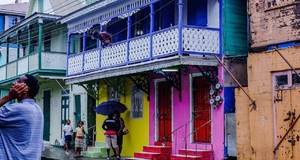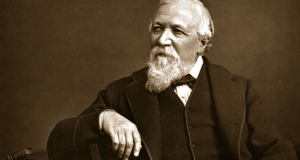Cultural Tensions and Hybrid Identities in Derek Walcott's Poetry
By
2015, Vol. 7 No. 09 | pg. 2/2 | « For example, in the first part of the poem, the arrival of the African slaves on the Islands is described by drawing a parallel with the events in the Genesis. Walcott not only uses Biblical allusions, he also extensively uses the sea as a metaphor. The history of the Caribbean people lies in the “grey vault” (I. 3) of the sea. The sea is the only witness to the suffering of the African slaves brought to the Islands, many of whom died on the way and have turned into corals lying in the sea-bed. In the poem, the expansive nature of the sea stands for the complexity of Caribbean history which cannot be understood by the coloniser’s markers of history- monuments, battles, martyrs, Renaissance etcetera. The poems “A Far Cry from Africa,” “The Sea is History,” and “Names” can, therefore, be effectively seen as presenting an understanding of the complexities inherent in Caribbean history and identity. These poems are also attempts on the part of the poet to rewrite the history of the Caribbean people from a subaltern perspective. However, Walcott’s poems not only uncover the many oppressions that the Caribbean people have been subjected to in the past, but also present a celebration of the hybridity and cosmopolitanism of Caribbean culture. Postcolonial theorists like Homi K. Bhabha and writers like Salman Rushdie see hybridity as a critical position. In The Location of Culture, Bhabha does not see hybridity as a means of resolving different elements of identity. Rather, he sees hybridity as “repetition of discriminatory identity effects.” This repetition, according to Bhabha, creates an excess that unsettles colonial authority in manner so as to “turn the gaze of the discriminated back upon the eye of power” (112). Rushdie sees hybridity as a vantage point in a postcolonial postmodern world, which allows one to question both the host-land and the homeland.As already mentioned, Walcott advocates the creation of a language which is an “electric fusion of the old and the new.” This fusion or hybrid formation is celebrated in Walcott’s poetry. Firstly, it is celebrated through metaphors. Though these metaphors are in English, they capture the natural landscape of the Caribbean Islands in an extremely vivid manner. The layered metaphor of the threshing of grains and the appearance of the dust as ibises in “A Far Cry from Africa” is an apt example- “Threshed out by beaters, the long rushes break / In a white dust of ibises…” (11-12). Other examples include the metaphor of the osprey’s cry in “Names” and the metaphors of the sea in “The Sea is History.” This creation of the hybrid language and culture is seen in Walcott’s poems as empowering. In “Names,” the palms of Caribbean Islands are seen as greater than Versailles since no man has made them and no man shall destroy them, “except the worm, who has no helmet, / but always the emperor” (II. 74-75). The comparison of the Caribbean people to worms is significant for it represents the power of supposedly trivial beings. Another way in which hybridity is celebrated in Walcott’s poems is through polyphony. As one is aware, Walcott is a well-known dramatist besides being a poet. A number of his poems are very dramatic in their use of imagery and voice. In “Names,” for example, besides the voice of the poetic persona, there is the voice of the French teacher. Similarly, in “The Sea is History,” there is the voice of the unnamed coloniser who asks the questions- “Where are your monuments, your battles, martyrs?” (I. 1) and “but where is your Renaissance?” (I. 33). The cultural theorist, Mikhail Bakhtin, theorised polyphony and heteroglossia in his discussions of the novel in “Discourse in the Novel.” Bakhtin writes, “Heteroglossia… is another’s speech in another’s language… [it] constitutes a special type of double-voiced discourse” (324). The potential of subversion of political structures through multiple voices is suggested in Bakhtin’s theorisation, and the same ideas have been taken up by postcolonial theorist like Bhabha in the discussion of hybridisation through which the gaze is turned back at the empire. In Walcott’s poems, the incorporation of multiple voices is both a celebration of the hybridity of Caribbean culture as well as a means of subversion. It must also be noted that while Walcott celebrates the hybridity and cosmopolitanism of Caribbean culture, it is in no way an uncritical stance. In the celebration of hybridity, it is possible that the imbalances of power relations may be either neglected or negated. Walcott, however, never loses sight of the colonial past of the Caribbean Islands. In an interview recorded in Conversations with Derek Walcott, Walcott says: The whole idea of America, and the whole idea of everything on this side of the world… is imported; we’re all imported- Black or Spanish… The difficult part is the realization that one is part of the whole idea of colonization… the rare thing is the resolution of being where one is and doing something positive about that reality. (203) Furthermore, Walcott is not blind to the shortcomings of the culture and politics of the newly independent states in the Caribbean Islands. In the second part of “The Sea is History,” for example, he is critical of the social and political institutions of the new independent states- the council of priests is compared to flies, the bureaucrats are herons which can’t fly high, and the politicians are like bullfrogs bellowing for votes. The implication is that the new states are still nascent in their culture and politics; there is still a long way to go for the “rumour” of “History, really beginning” (II. 79-80) in these states to echo throughout the world. In conclusion, Walcott, in his poems, explores the racial, colonial, and cultural tensions inherent in the Caribbean history and identity. Through his poems, he attempts to rewrite the history of the Caribbean people from a subaltern perspective. He celebrates the hybridity and cosmopolitanism of Caribbean culture, but he never loses sight of its colonial past and remains critical of the forces shaping its future. ReferencesBaer, William, ed. Conversations with Derek Walcott. USA: University of Mississippi Press, 1966. Google Book Search. Web. 18 April 2015. Bakhtin, M. M. “Discourse in the Novel.” The Dialogical Imagination: Four Essays. Ed. Michael Holquist. Trans. Caryl Emerson and Holquist. Austin: University of Texas Press, 1981. Print. Bhabha, Homi K. The Location of Culture. New York: Routledge, 1994. Print. Fanon, Frantz. Black Skin, White Masks. New York: Grove Press, 2008. Print. Said, Edward W. Orientalism: Western Conceptions of the Orient. India: Penguin, 2014. Print. Thiong’o, Ngugi wa. Decolonising the Mind: The Politics of Language in African Literature. Nairobi: East African Educational Publishers Ltd., 2004. Print. Walcott, Derek. “The Antilles: Fragments of Epic Memory” (Nobel Prize Acceptance Speech). The Nobelprize.org. 7 Dec. 1992. Web. 18 April 2015. ---. “What the Twilight Says: An Overture.” Dream on Monkey Mountain and Other Plays. New York: Farrar, Straus and Giroux, 1970. Print. Suggested Reading from Inquiries Journal
Inquiries Journal provides undergraduate and graduate students around the world a platform for the wide dissemination of academic work over a range of core disciplines. Representing the work of students from hundreds of institutions around the globe, Inquiries Journal's large database of academic articles is completely free. Learn more | Blog | Submit Latest in Literature |


















